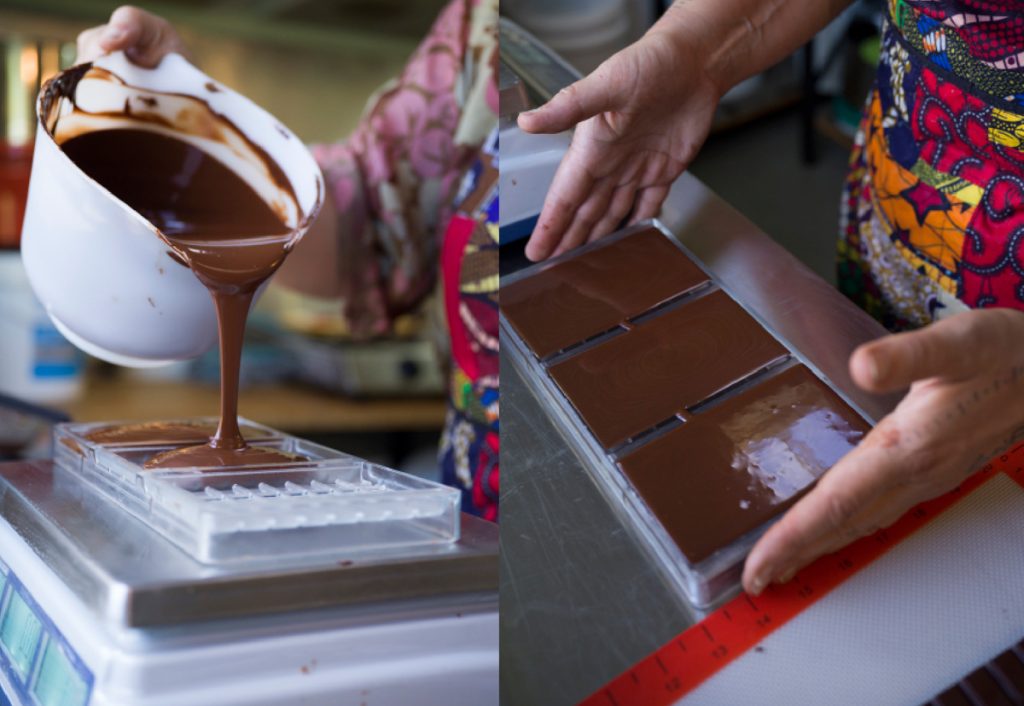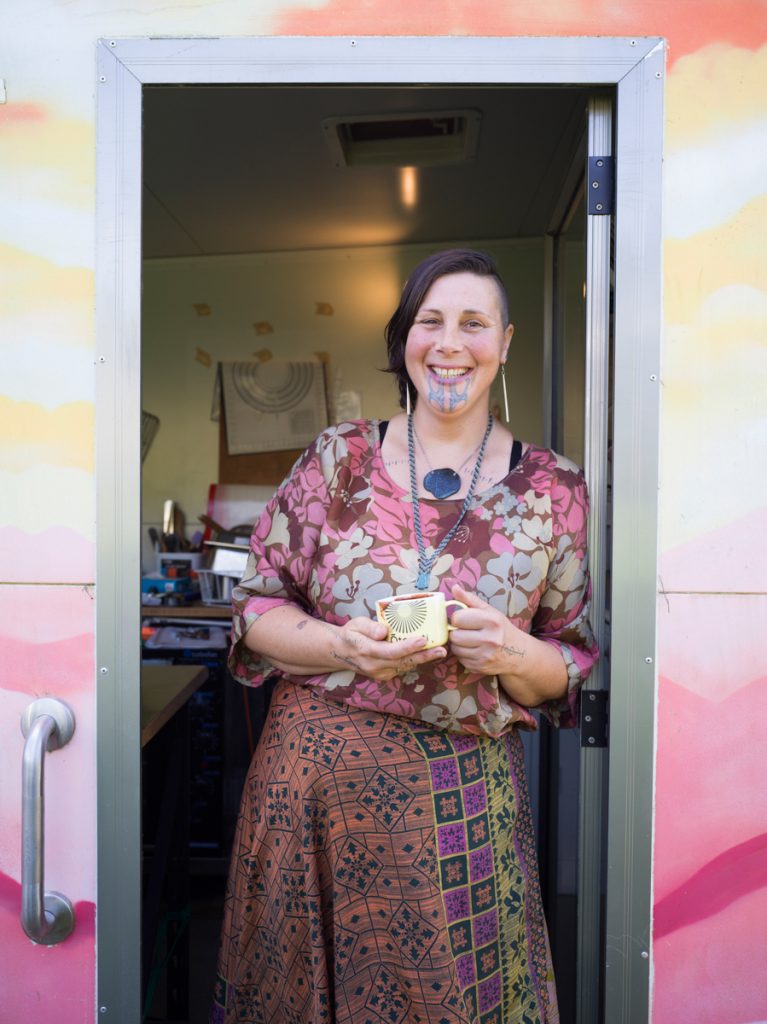Saved by Cacao
From a small food trailer on the berm outside her home, Ōtepoti entrepreneur Marōtini Clements produces Ka kā wā Confectionery – artisanal bean-to-bar chocolate that promotes health, wellness and regenerative practice.
Words Claire Finlayson Photos Rachael McKenna

Screenshot
You’d be hard-pressed to find a more cacao-smitten human than Marōtini Clements (Waitaha, Kāti Māmoe, Kāi Tahu, Scottish, Irish, Dutch). And with good reason too, for she credits the health-buttressing properties of the cacao bean for rescuing her. ‘I can’t thank cacao enough for what it’s done for me. It’s literally changed my life.’
That life was in a dire state 15 years ago. Marōtini was riddled with pain – much of which she blames on the toxic chemical soup she inhaled during her time as a signwriter. ‘I got really sick – I was poisoned by solvents. The doctors didn’t know what to do – they just kept telling me to take painkillers. So I collected all of my medical files and literally walked out of the doctor’s office because I knew there was something wrong with me. I had to move home to my parents’ house to recover. I basically lay in bed, couldn’t move much, couldn’t look after myself. I just had to focus on nourishing myself.’
A couple of subsequent career switches (zero-waste fashion and zero-waste management) upped her creative and ethical satisfaction but there was minimal let-up on the health front. That’s when cacao found her.
‘I started using cacao on a daily basis and it shifted my endometriosis, anxiety and depression completely. I also have a hereditary nerve condition and used to be constantly inflamed, but I’m not having to deal with that now either. It’s brought joy back to my body as well. I laugh and smile a lot more because there’s increased serotonin and dopamine happening in my body.’
The humble cacao bean contains nutritional multitudes: iron, magnesium, zinc, calcium, polyphenols, and antioxidants. It’s said to reduce inflammation and aid the cardiovascular system and is thought to be good for cognitive function, skin, digestive health, immunity, and energy levels.
Marōtini says eight roasted beans (or 30 grams of chocolate) per day is sufficient to get a good measure of therapeutic value from cacao. She’s partial to preparing hers as a hot brew, whisking cacao paste with hot water and a little natural sweetener such as coconut sugar to create a rich, velvety concoction. She calls it ‘a hug in a mug’. (Though in her case, it’s more likely to be four mug-hugs each day. Work perks, obviously).
Asked why more people aren’t prostrating themselves before this superfood, Marōtini thinks it owes much to rampant cacao-cocoa confusion. Cacao (raw or minimally processed and nutritionally dense) is often mistaken for its cousin cocoa, which is subjected to nutrient-depleting high temperatures and usually married to that less honourable partner: sugar.

‘It’s a sugar-filled candy these days. Why would we ruin cacao by diluting it? Many people don’t understand that cocoa has the butter stripped out of it – the beautiful fat that does the work in the body. Through getting sick all those years ago it’s really important to me that we actually nourish ourselves. Our bodies are our temples and we should be looking after them.’
Given Marōtini’s innate entrepreneurial flair, it’s no surprise that she decided to hitch herself more fully to this noble bean and move from eager consumer to cacao champion and chocolatier. She says ‘cacao dealer’ might be a more accurate term. ‘That’s what it feels like when I’m dropping packages off in people’s letterboxes.’
In 2022 she undertook training at The Cacao Ambassador in Ōtautahi before learning the ways of the concher machine (the place where the bean-to-chocolate alchemy happens). She fashioned a chocolate-ready kitchen out of a rented food trailer (her 40-square-metre home being culinarily prohibitive), parked it up near the berm, and began her cacao adventuring.
She named her brand Ka kā wā Confectionery to pay homage to the Mayan word for cacao (kakaw) while also saluting her own cultural identity. ‘In te reo Māori, Ka kā wā means “to allow time and space to reignite the inner fire” – and that’s exactly what cacao has done for me. I’m trying to bring the conversation back to cacao as a medicine, a rongoā – as something to support us.’
Marōtini sources her organic beans from the Solomon Islands and Papua New Guinea via The Cacao Ambassador – an organisation that works with Pacific farmers to ensure a transparent and ethically driven supply chain. ‘Because I’m working with Pacific cacao that hasn’t come from its original whakapapa of Peru, I try to imbue it with that sacredness again and create some kind of tapu and tikanga around it. I karakia every time an ingredient goes into the machine and every time it comes out. It’s mauri-rich cacao.’
As for the future of Ka kā wā, Marōtini is keen to scale the business up, do her own bean roasting on-site, expand her product range, and buy a cacao cart to take to bigger events. Until then, she’ll continue that serotonin-sweet alchemy from her petite trailer, engulfed in an ambrosial cloud of steaming cacao, pushing hugs in mugs.

Screenshot
What is Cacao?
Cacao hails from the seeds of the Theobroma cacao tree (Theobroma literally translates to ‘food of the gods’) and is the key ingredient in chocolate. Native to Central and South America, it has been cultivated for thousands of years and was originally used by indigenous cultures like the Chinchipe, Maya, and Aztecs in sacred ceremonies and rituals. It was thought to impart clarity, strength and spiritual connection. The seeds (cacao beans) are harvested from pods, fermented, dried, and sometimes lightly roasted to make cacao paste, powder, butter, or nibs.

Cacao Ritual
Words Marōtini Clements
At Ka kā wā we celebrate the ritual in the everyday. Take notice of the small moments, the bubbles of joy, the moments of sadness, and allow them to be held and processed in any way that feels right to you in the moment. We are big fans of somatic movement, breath work and hands in the soil as medicine for the soul. Alongside Ka kā wā these create potent moments of release, energising and uplifting, allowing creation to unfold the journey ahead.
Ka kā wā is infused with wahitapu and Waitaha karakia, the sacred intention is placed directly into your cacao to create a safe space for you to unfold.
Take as much time as you need, or have. If it’s limited then allow your heart to carry your intention with you for the rest of your day and visit that commitment to self in your in-between daily moments.
Allow yourself the space to enjoy and nourish your soul.
Brew your cacao with thoughtfulness and attention.
You will need 200 ml of spring water and 30 g of Ka kā wā to make a single brew.
I often make a small pot in the morning to have during the day’s varied activities. I am never far away from a cup of cacao.
Heat your water and chop 30 g of cacao from your block.
Place your cacao in the pot and mix to combine.
Allow it to simmer gently to activate and emulsify the gorgeous cacao butter for a short time.
Now you are ready to pour into your favourite mug and create yourself a tapu space to sip.
You can drink it bitter or add sweetener at any point, my go-to choice is coconut sugar.
Take your time, let the cacao envelop your senses, hold her to your heart, speak with your intention before you sip, and call your tupuna forth to sit with you as you dream of what is to come.
Create your own personalised karakia in whatever language is appropriate for you, as always take what resonates and leave the rest. It’s your time and space to create a right relationship with self.

